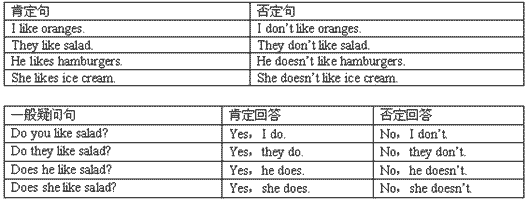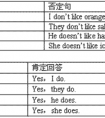选出句子中错误的选项,并将正确答案写在横线上。( ) 1. I like listen to music._________________ A BCD ( ) 2. There are a stamp show on Sunday. ________________-六年级英语
7.有些表示状态和感觉的动词表示现在发生的具体行为时,只用一般现在时,而不用进行时态。
8.表示现在发生的具体动作或存在的状态
9表示格言或警句中。 e.g Pride goes before a fall. 骄者必败。
注意:此用法如果出现在宾语从句中,即使主句是过去时,从句谓语也要用一般现在时。
例:Columbus proved that the earth is round..
第一句用一般现在时,用于操作演示或指导说明的示范性动作,表示言行的瞬间动作。
再如:Now watch me,I switch on the current and stand back.
第二句中的now是进行时的标志,表示正在进行的动作的客观状况,所以后句用一般现在时。

第三人称单数的构成见下表:
|
词 |
构成 |
举例 | |
|
一般情况 |
词尾+s |
动词原形 |
第三人称单数 |
|
work(工作) |
works | ||
|
以-ch, -sh, s, x, o结尾 |
词尾+es |
teach(教) |
teaches |
|
以“辅音字母+y”结尾 |
变y为i,再加es |
fly(飞翔) |
flies |
一般现在时的特殊用法:
一些动词可用一般现在时来表达现在进行时:
verbs of the senses: hear,see,taste,smell,feel
verbs of the thinking: believe,know,mean,realize,think,remember
verbs of the linking: dislike,fear,heat,like,love,want
verbs of the possession: belong,have,own,possess
考点名称:there be 句型
- There be句型:
是英语中常用句型,意思是“有”,表示“人或事物的存在”。
There在此结构中是引导词,已经没有副词“那里”的含义。
There be后面的名词是句子的主语,属倒装结构。常用“There + be+名词+地点/时间状语”的结构。 - There be结构的用法:
A、肯定结构:
There be句型的肯定结构表示“某处存在某物或某人”或“某时发生某事”。
a. There is+单数可数名词/不可数名词+地点/时间状语。
例:There is a cat under the chair. 椅子下面有一只猫。
There is some water in the bottle. 瓶子里有些水。
b. There are +复数名词+地点/时间状语。
例:There are some apples in the basket. 篮子里有一些苹果。
B、否定结构:There be句型的否定结构是在谓语动词be的后面加“not (any)”或“no”.
例:There are no tables in the room. 或者There are not any tables in the room. 房间里没有桌子。
C、疑问结构:There be句型变成疑问式时,要把there和谓语动词be的位置互换。
例:Is there a pen in the schoolbag? 书包里有一支笔吗? - Therebe结构和have的区别与联系:
1.区别点:
there be 意为存在,强调某地有某物,不表示所属关系;
have 表示所有关系, 强调某人或某地有某物,这是其基本用法。如:
There are some trees in front of the house.房前有些树。
Tom has many friends in China.汤姆在中国有许多朋友。
2.相同点:
在表示结构上的含有时,既可以用there be 句型,也可以用have(has) 来表示。如:
中国有许多长河。
There are many long rivers in China.
China has many long rivers.
三月份有多少天?
How many days are there in March?
How many days has March? - There be结构中的be动词的确定:
A、there be 结构中的谓语动词be在人称和数上应与其后的主语保持一致。主语是不可数名词或单数可数名词时用is,是复数时用are。
例:There is a flower in the bottle. 瓶里有一朵花。
There is some money in the purse. 钱包里有些钱。
B、若句子中有几个并列的主语时,be的形式要与离其最近的一个主语在人称和数上保持一致。
例:There is a boy, a girl and two women in the house. 房子里有一个男孩,一个女孩和两个妇女。
There are ten students and a teacher in the office. 办公室里有十个学生和一个教师。
There be结构的句型转换:
A、否定句:
there be的否定式通常在be后加not构成(在口语中be时常与not缩写在一起)。如果句中有some,一般要变成any。 例:
There are some children in the picture.
There aren't any children in the picture.
B、一般疑问句及其答语:
把be提到there前,首字母大写,句末用问号即可。其肯定答语是Yes, there is / are;否定答语为No, there isn't / aren't。 例:
— Are there two cats in the tree?
— Yes, there are. (No, there aren't.)
C、特殊疑问句及其回答
a. 提问句子的主语(包括主语前的修饰语)时,句型一律用“what is+地点介词短语?”(无论主语是单数还是复数都用is)。
例:There are some birds in the tree. → What's in the tree?
b. 就there be后面的地点状语进行提问时,句型用“where is/ are+主语?”
例:There is a car in the street. → Where is the car?
c. 提问可数名词(主语)前的数量时,用how many,句型结构为“how many+ 复数名词+are there+其它)”(主语无论是单数还是复数,be通常要用are)。
例:There are three books on the desk. → How many books are there on the desk?
- 最新内容
- 相关内容
- 网友推荐
- 图文推荐
上一篇:看图完成下面的句子。1. He likes ____________________.2. Does he like diving? No, ______________. He likes ______________.3. I like ______________________.-六年级英语
下一篇:I like _____________.[ ]A. swimB. swimingC. swimming-六年级英语
零零教育社区:论坛热帖子
| [家长教育] 孩子为什么会和父母感情疏离? (2019-07-14) |
| [教师分享] 给远方姐姐的一封信 (2018-11-07) |
| [教师分享] 伸缩门 (2018-11-07) |
| [教师分享] 回家乡 (2018-11-07) |
| [教师分享] 是风味也是人间 (2018-11-07) |
| [教师分享] 一句格言的启示 (2018-11-07) |
| [教师分享] 无规矩不成方圆 (2018-11-07) |
| [教师分享] 第十届全国教育名家论坛有感(二) (2018-11-07) |
| [教师分享] 贪玩的小狗 (2018-11-07) |
| [教师分享] 未命名文章 (2018-11-07) |

![Does she like ____on weekends? [ ]A. going shoppingB. go shoppingC. go shop-六年级英语](http://www.00-edu.com/d/file/ks/4/1/55/2019-08-27/smalle6a92ee9e61a2aa039771cc65dedb40c1566919813.jpg)

![_____ is exercise.[ ]A. SwimmingB. SwamC. Swiming-六年级英语](http://www.00-edu.com/d/file/ks/4/1/55/2019-08-27/small40973c49a53101aac60eff6217bb35b51566919892.png)
![Myfavouriteschoolworkisbooks.[ ]A.readsB.readingC.read-四年级英语](http://www.00-edu.com/d/file/ks/4/1/55/2019-08-27/small8a67cf251e3192e64cc06a4ac60a96381566918811.png)
![The girl is very good at _____________. [ ]A. readB. readsC. writerD. writing-五年级英语](http://www.00-edu.com/d/file/ks/4/1/55/2019-08-27/smalla9ccf813980fe587df504d29b874bb8c1566919421.png)
